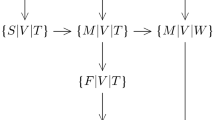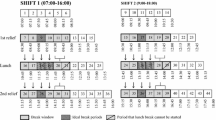Abstract
The purpose of this paper is to investigate the benefits that flexibility offers in daily shift scheduling, especially when demand is uncertain. The different forms of flexibility considered include shift start times, the number of breaks, break lengths, and break placement. Five related mixed-integer programming models are developed and used to compare break scheduling in advance and either sequentially or in real time for various shift and break profiles. The first model integrates the shift and break assignments while the second model assigns shifts only. The third and fourth models assume an optimal set of shifts. In the former case, the goal is to assign as many breaks as possible without violating demand requirements; in the latter case, the objective is to minimize undercoverage while ensuring that all shifts receive their required breaks. The fifth model takes a rolling horizon approach and provides the greatest advantage when responding to unexpected demand fluctuations over the day. Tests were performed using work requirements for ground handlers at a major European airport and showed in part that when demand is known and the most flexible break type is used, the total uncovered periods in a day can be decreased by up to 94% (down from 270 to 16). When demand is uncertain, we found that using our rolling horizon procedure reduces undercoverage by up to 41% compared to scheduling breaks in advance.





Similar content being viewed by others
References
Addis B, Carello G, Grosso A, Tanfani E (2015) Operating room scheduling and rescheduling: a rolling horizon approach. Flex Serv Manuf J 28(1):206–232
Akyin T (1996) Optimal shift scheduling with multiple break windows. Manag Sci 42(4):591–602
Bard JF, Purnomo HW (2005) Hospital-wide reactive scheduling of nurses with preference considerations. IIE Trans 37(7):589–608
Bard JF, Purnomo HW (2007) Cyclic preference scheduling of nurses using a lagrangian-based heuristic. J Sched 10(1):5–23
Bechtold SE, Jacobs LW (1990) Implicit modeling of flexible break assignments in optimal shift scheduling. Manag Sci 36(11):1339–1351
Cezik T, Günlük O (2004) Reformulating linear programs with transportation constraints with applications to workforce scheduling. Nav Res Logist 51(2):275–296
Dantzig GB (1954) A comment on Edie’s traffic delays at toll booths. Oper Res 2(3):339–341
Furini F, Kidd MP, Persiani CA, Toth P (2015) Improved rolling horizon approaches to the aircraft sequencing problem. J Sched 18(5):435–447
Hur Y (2017) Optimization models for manufacturing and personnel scheduling. Ph.D. dissertation, Graduate Program in Operations Research and Industrial Engineering, The University of Texas at Austin
Janaro RE, Bechtold SE (1985) A study of the reduction of fatigue impact on productivity through optimal rest break scheduling. Hum Factors 27(4):459–466
Kiermaier F, Frey M, Bard JF (2015) The flexible break assignment problem for large tour scheduling problems with an application to airport ground handlers. Working paper, TUM School of Management Technical University Munich. www.om.wi.tum.de/fileadmin/w00bdm/www/_migrated_pics/s1-ln1960958995844769-1939656818Hwf428913699IdV-202101754619609589PDF_HI0001.pdf
Kiermaier F, Frey M, Bard JF (2016) Flexible cyclic rostering in the service industry. IIE Trans Oper Eng Anal 48(12):1139–1155
Kim K, Mehrotra S (2015) A two-stage stochastic integer programming Approach to integrated staffing and scheduling with application to nurse management. Oper Res 63(6):1431–1451
Lim JG, Mobasher A, Bard JF, Najjarbashi A (2016) Nurse scheduling with lunch break assignments in operating suites. Oper Res Health Care 10:35–48
Moondra SL (1976) An LP model for workforce scheduling for banks. J Bank Res 7:299–301
Parisio A, Jones CN (2015) A two-stage stochastic programming approach to employee scheduling in retail outlets with uncertain demand. Omega 53:97–103
Rekik M, Cordeau JF, Soumis F (2004) Using Benders decomposition to implicitly model tour scheduling. Ann Oper Res 128(1):111–133
Rekik M, Cordeau JF, Soumis F (2010) Implicit shift scheduling with multiple breaks and workstretch duration restrictions. J Sched 13(1):49–75
Smet P, Brucker P, De Causmaecker P, Vanden Berghe G (2016) Polynomially solvable personnel rostering problems. Eur J Oper Res 249(1):67–75
Sungur B, Ozguven C, Kariper Y (2017) Shift scheduling with break windows, ideal break periods, and ideal waiting times. Flex Serv Manuf J 29(2):203–222
Thompson GM (1995) Improved implicit optimal modeling of the labor shift scheduling problem. Manag Sci 41(4):595–607
Thompson GM, Pullman ME (2007) Scheduling workforce relief breaks in advance versus in real-time. Eur J Oper Res 181(1):139–155
Whitt W (2006) Staffing a call center with uncertain arrival rate and absenteeism. Prod Oper Manag 15(1):88–102
Widl M, Musliu N (2014) The break scheduling problem: complexity results and practical algorithms. Memet Comput 6(2):97–112
Author information
Authors and Affiliations
Corresponding author
Appendices
Appendix A: flight delay update procedure
For the first forecast for flight f, we use the derived distributions to get a delay df (which can be positive or negative); for each subsequent forecast, we draw another sample but from a modified distribution with a mean and variance that shrinks geometrically from one iteration to the next. However, we always maintain the “direction” of the delay. If the first delay is positive meaning that the flight will be late, all updated samples are restricted to be positive. For example, if we draw + 30 as the first sample, this means this flight will be delayed 30 min. An hour later at the first update, it is not likely that the forecast would indicate that the flight is now expected to be only, say, 5 min late. This means that we don’t want a sample value of − 25, or more generally, that we want to preserve the sign of subsequent updates for each flight f. The rational for this restriction is empirically based. Once the flight arrival time is updated within its scheduled 4-h window, the historical data indicate that few if any delays shrink. For those rare cases in which the reverse is true, the reductions (or increases) are typically minimal.
Flight_Delay_Update_Procedure
- Input :
-
Solution timespan Δs, current period t, arrival distributions for all points of origin
- Output :
-
New arrival times for flights scheduled to arrive in the interval [t, t + Δs−1], updated workforce demand
- Step 1:
-
Determine the set of flights that are scheduled to arrival in the interval [t, t + Δs−1]; call the set A(t)
- Step 2:
-
For each f ∈ A(t), get its corresponding delay distribution, call it Gf(d), and modify it according to the number of times it has been called previously
- Step 3:
-
Find a sample point df in Gf(d)
- Step 4:
-
If this the first update for f, then
add df to the scheduled arrival time
Else
add |df| to the most recent arrival time
Go to Step 2
- Step 5:
-
Recalculate staffing demand for the new arrival times
The sampling procedure mentioned in Step 2 depends on the particular distribution and its parameters. The details are given in “Appendix B”. Once the new arrival times are found, the staffing demand is recalculated in Step 5 and the next subproblem is solved. That is, we solve the current subproblem, fix the solution for the interval [t, t + Δr−1], and move to next iteration [t + Δr, t + Δr +Δs−1]. At this point, Flight_Delay_Update_Procedure is called again.
Appendix B: sampling procedure for arrival time delays
The procedures and modifications for sampling flight delays are a function of the delay distribution, which depends on the point of origin. We begin with the log-logistic distribution F(α, β) for a given scale parameter α and a given shape parameter β. For sampling purposes, we define a minimum value l (< 0), random rational number p, and the update iteration number n with the goal of obtaining a sample delay d. Since the log-logistic distribution is continuous on the set of positive real numbers, we add the minimum value l when we sample to allow for negative delays (i.e., early arrivals).
Sampling_Procedure_Log-logistisc_Distribution
- Input :
-
Log-logistic distribution with known parameters α, β, l, n
- Output :
-
Sample delay d
- Step 1:
-
Generate a random rational number p from U[0, 1]
- Step 2:
-
If n = 1, then
Generate a sample value d such that \(d = F^{ - 1} \left( {p;\alpha ,\beta } \right) \, = \alpha (p/(1 - p))^{1/\beta } + l\)
Else
Modify parameters based on the number of updates n by putting α ← α/2n, β ← β·2n, l ← l/2n
Generate a sample value d where \(d = F^{ - 1} \left( {p;\alpha ,\beta } \right) \, = \alpha (p/(1 - p))^{1/\beta } + l\)
Rounding a sample delay d and Return
In the analysis, we used the following parameter values.
- Asia:
-
α = 51.6, β = 3.84, l = −50
- America:
-
α = 74.7, β = 4.73, l = −86
- Other:
-
α = 52.76, β = 4.47, l = −47
For flights originating in Germany and the remaining European countries as a whole, we constructed empirical piecewise linear delay distributions based on the original flight arrival data. Let m be the number of flights in either of the corresponding data sets. The delays associated with each of the m flights are arranged in nondecreasing d1, d2,…,dm, and then grouped into k adjacent intervals [aj−1, aj), such that the jth interval contains mj delays, j = 1,…,k. We define a minimum value l (< 0), maximum value u (> 0), random rational number p, and the update iteration number n. Note that a0 is the minimum value l and ak is the maximum value u.
Our piecewise linear empirical distribution function G(d) for delay d is specified as follows: G(a0) = 0 and G(aj) = (m1 + m2 +···+ mj)/m. Then, interpolating linearly between the aj’s, we define
Sampling_Procedure_Empirical_Distribution
- Input :
-
Empirical distribution G(d) from Eq. (4a) with known parameters l, u, n along with the intervals [a0, a1), [a1, a2),…, [ak-1, ak]
- Output :
-
A sample delay d
- Step 1:
-
If n > 1, then put l ← l/2n, u ← u/2n and aj ← aj/2n, j = 1,…,k \\ first update when n = 1
- Step 2:
-
Draw a random rational number p from U[0,1]
- Step 3:
-
Find the interval aj-1 and aj such that G(aj-1) ≤ p ≤ G(aj); solve Eq. (4b) after setting G(d) = p to find a sample delay d
In the analysis, we used the following parameter values.
- Germany:
-
l = − 35, u = 97, k = 84 with m = 6579
- Europe:
-
l = − 67, u = 136, k = 98 with m = 16,186
In Sect. 6, we give the Flight_Delay_Update_Procedure which, at Step 3, calls one of the above sampling procedures. For the log-logistic distribution, we multiply the shape parameter β by two and divide both the scale parameter α and minimum value l by two at each update. For the empirical distribution, we divide the minimum value l, the maximum value u and the interval boundary values aj, j = 1,…,k, by two at each update These modifications have the effect of reducing the variance of the selected distributions so that as n increases the sample value approaches zero.
Rights and permissions
About this article
Cite this article
Hur, Y., Bard, J.F., Frey, M. et al. An investigation of shift and break flexibility with real-time break assignments using a rolling horizon approach. Flex Serv Manuf J 31, 174–211 (2019). https://doi.org/10.1007/s10696-018-9305-2
Published:
Issue Date:
DOI: https://doi.org/10.1007/s10696-018-9305-2




